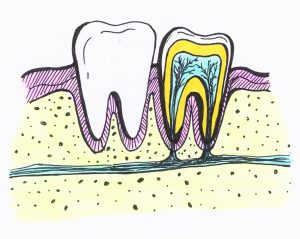
Author: Layal Bou Abdo, MSN
Illustrator: Angeline Boswell
27/10/2021
My daughter Kai has two loose teeth. Like any life experience, her journey with a loose tooth has become a scientific learning experience.
Below is how I answered her curious questions, and in the video, you can see how she explains what she learned. Let me know in the comment box how does learning happens at your home?
Mom, why do I have a loose tooth?
It is one of the human body’s medical wonders.
Humans are diphyodonts which basically means two sets of teeth. Many other mammals like dogs, cats and horses are diphyodonts too.
- Me: do you know why do we have teeth?
- Kai: to eat, talk, and smile
- Me: Exactly, they help us chew our food, bite, eat, talk and make sounds. Our teeth help us maintain the shape and structure of our jaw.
When we are born, we have 20 teeth inside our gum. These teeth start to push through and grow at the age of 6 months. It is when the baby starts teething.
These teeth are called baby teeth or milk teeth or what the dentists call deciduous teeth.
Baby teeth are essential to the development of the baby’s speech. They also help the baby to move from sucking on milk to eating proper meals.
Unlike our hair and nails, our teeth cannot actually grow, but the baby’s skull and jaw do. When we grow up, we need a new set of teeth to accommodate the change in our jaw sizes over time. The baby teeth start to fall out, and the adult teeth start coming in. Through childhood, we lose 20 baby teeth replaced by stronger, bigger, and longer permanent teeth.

When do baby teeth fall out?
It all depends on when the baby starts teething. The baby’s teeth start erupting at around six months of age. If the baby cuts his/her first tooth early at 3-4 months of age, chances are high that their first permanent tooth will grow in early as well (maybe around age 4-5 years old). If the baby didn’t cut his/her first tooth until close to age 1, then don’t expect permanent teeth to grow in until closer to age 7-8. The last baby tooth falls out at around 12-13 years of age.
By age 21, your child will likely have all 32 permanent teeth erupted. The permanent teeth are called succedaneous teeth.
How long does it take for a child’s wiggly tooth to fall out?
Loose teeth take between a few days to a few months to fall. You might speed up the process by wiggling it gently every day.
How to wiggle your tooth?
You can help out your tooth by pushing it with your tongue. You can also move it back and forth, from front to back, left to right and twist gently.
Mommy, do you have 20 teeth like me?
No, adults have 32 adult teeth. As we start having a new set of teeth, 12 new teeth erupt at the back of our mouth aside from the 20 that replaced the baby teeth. These teeth are the molars usually referred to as 6-year molars, 12-year molars and wisdom teeth.
In what order do baby teeth fall out?
In general, baby teeth fall out in the same order they grew in. The first teeth to get loose are the bottom incisors at the center followed by the right and left bottom incisors. Usually, teeth get loose in pairs. By the age of 8 years old, the child will lose all the front teeth (incisors) top and bottom. The next set of teeth you lose is going to be the lower canines and the first set of baby molars followed by the upper canines and the second set of baby molars.
This order might be different from a child to another especially, for the canines and the molars.
How will the teeth fall?
Each tooth is attached to one root that attaches the tooth to the gum. Except for the molars, they have 2-3 roots. When permanent teeth start to grow, they push the baby teeth up, causing the root to weaken and shorten until it disappears. That’s why you don’t see the root when the tooth is out.
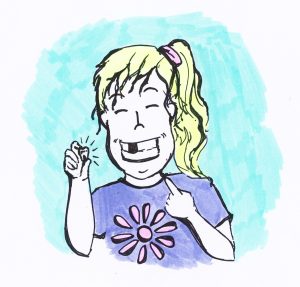 Can I pull my loose tooth?
Can I pull my loose tooth?
Pulling a loose tooth before it’s ready to come out on its own can break the root and cause an infection.
When the tooth is ready to be pulled out:
- Apply ice to numb the gums.
- Dry the tooth with clean tissue. The wet tooth is slippery.
- Rotate the tooth in one direction, and hold for 5 seconds.
- Twist the tooth in the other direction, and hold for 5 seconds. This technique will stretch the gum fibres and free the root.
- After pulling the tooth, your gum might bleed a bit. Bleeding is normal. We just need to apply clean tissue/cotton and bite on it until the bleeding stops for about 5-10 min.
To help with bleeding, you can rinse your mouth with warm water.
When it’s ready to fall out, a loose tooth might teeny tiny hurt you when removed. After it falls out, your gum might be a bit painful when you touch it and might become slightly red.
Do loose teeth hurt?
No, they don’t hurt unless you hardly bite on objects like an apple or a carrot for the incisors. For the baby molars, chewing harder or crunchier food might be more difficult. That’s why it will be better sometimes to eat on the other side or avoid the food that will cause you discomfort.
You might also feel discomfort when brushing your loose tooth. The pain is from the gum that surrounds the tooth and not from the tooth. The discomfort might increase due to plaques’ poor mouth hygiene. That’s why you should brush and floss your teeth routinely, to remove the plaque and the bacteria and prevent the pain. Be gentle, but do not forget to brush your loose teeth.
We can always give you a pain killer if you experience pain.
Did you know?
- Shark teeth happen when a permanent tooth is growing in while the baby tooth is still in place. The result is rows of teeth formed by the baby tooth forward and the adult tooth backward.
- Elephants, kangaroos, and manatees have multiple sets of teeth that grow in the back of their mouth and migrate forward as their front teeth fall out. They are polyphyodonts.
- Toothed fish like sharks, alligators are known as polyphyodonts, animals that have multiple sets of replacement teeth.
- Rodents and rabbits’ incisors grow continuously, so they require regular gnawing to keep their teeth at a healthy length.
We are certain your kid asks you health (human & animal) questions that genuinely leave you stumped! Leave a comment below and we are happy to answer “why” in future blogs.
Copyright © 2021 Little Medical School Ottawa

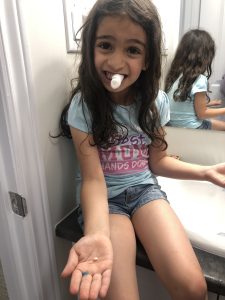
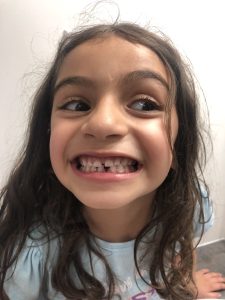
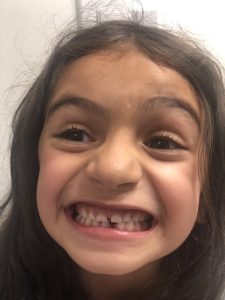

I should have read this article beforehand and learned that pulling a loose tooth before it’s ready could break it and result in an infection. My little brother is in pain because he forcibly tried to remove his loose tooth. It hasn’t come off yet, but it’s more sensitive than it used to be. I’ll take him to a dentist to see if they can remove it now.
Sorry to hear about your brother and we wish him a quick recovery. We hope that it’s a simple inflammation that will resolve soon.